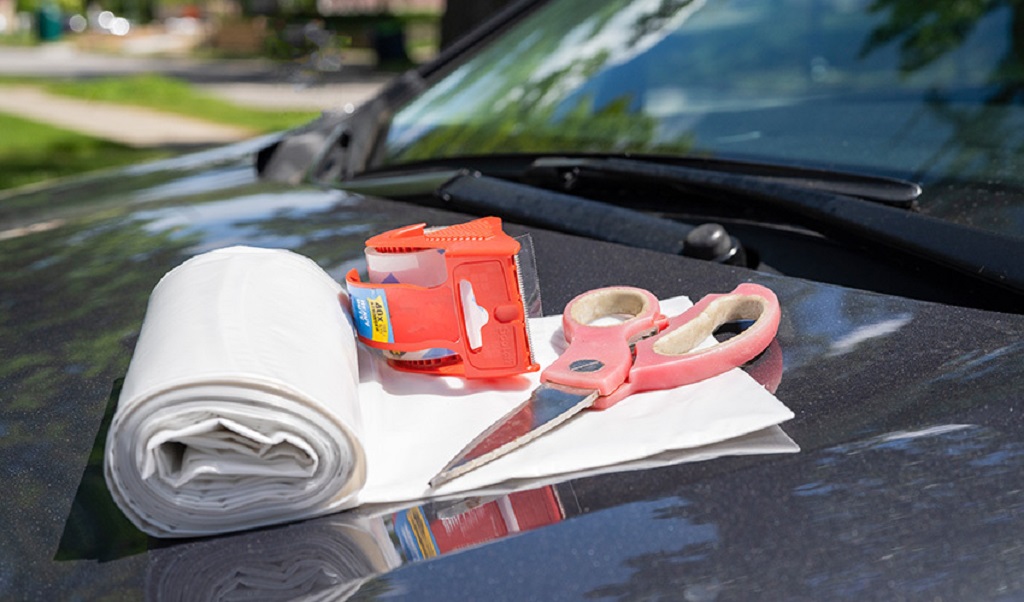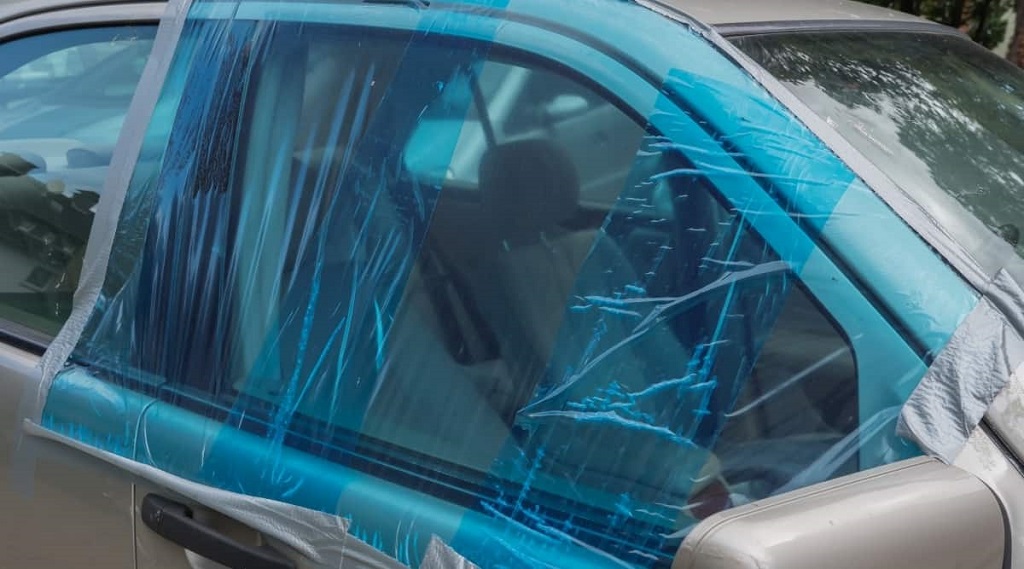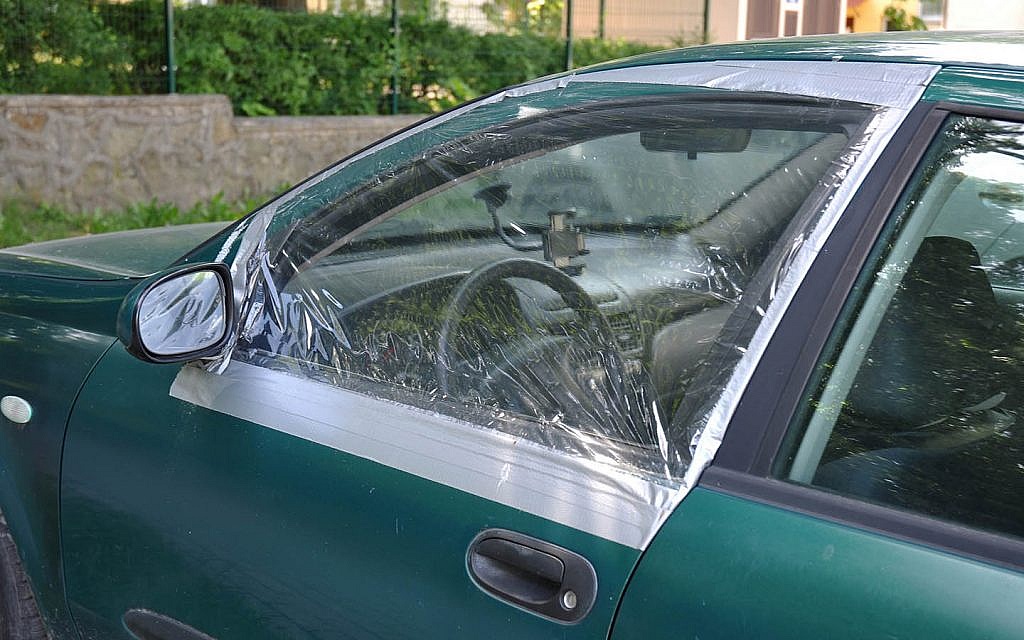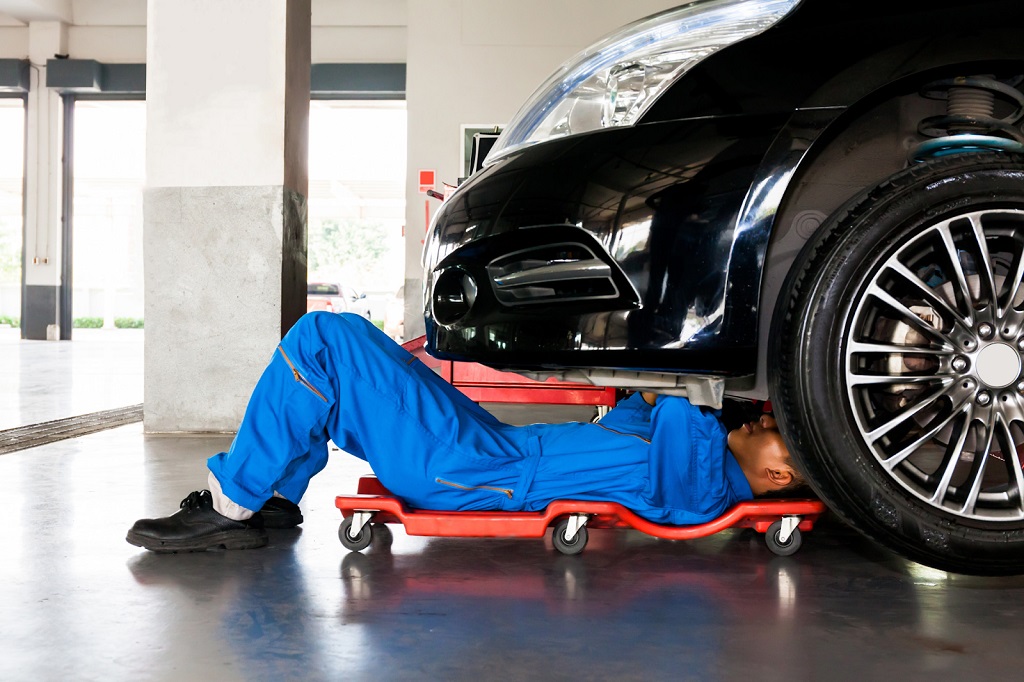Having a broken car window can be an annoying and inconvenient problem. Returning to your vehicle to find shattered glass all over the seats and floor can be both jarring and unsafe. A damaged window poses serious issues beyond just an eyesore. The open gaping hole now allows outside weather elements like rain, wind, and snow to easily enter the cabin, exposing the interior to possible water damage or stains. Without a window barrier, road noise floods in unfettered, creating loud rushes of air that make driving an uncomfortable racket. It also presents a major security risk as thieves can now effortlessly reach in and steal valuables left in the car.
Not only are your belongings vulnerable, but the structural safety of the vehicle is now compromised with a missing window. Covering up a broken window as soon as possible is an easy and affordable temporary fix to contain these issues while you save up the money to get your window professionally repaired or replaced. Here are some tips on how to cover broken car window.
Assessing the Damage
The first step is to assess the severity of the damage. Is it a small crack or chip, or is the entire window fully shattered? For small cracks, you may be able to get away with using tape as a quick fix. But for anything larger, you’ll need to cover the window more substantially.
Carefully check where the break originated from. Was it hit by a rock or some other object? Or did the window crack due to age and wear and tear? This can help you determine the best temporary covering based on the window’s condition.
Also look to see if the broken glass has caused any other damage, like scratches on the door panel or frame. Avoid touching any broken shards with your bare hands to prevent injury. Wear gloves and safety glasses if handling broken window glass.
Removing Broken Glass
Before covering up the window, you’ll need to properly remove any remaining shards of broken glass. Even the tiniest splinter left behind can become a hazard over time. Carefully remove all pieces of glass from both inside and outside the car.
Use a vacuum cleaner attachment, brush, or even wide tape to lift glass fragments. Be sure to get into crevices and clean under window seals. Never use your hands directly even if wearing gloves, as broken glass can tear through material.
Check under seats and on floor mats for stray pieces that may have scattered when the window initially broke. Discard any shards appropriately. Broken glass should never be placed in recycling bins or trash cans used by waste collectors, as it can pose a safety risk. Wrap shards securely in the newspaper or a bag before discarding them.
Protecting from Weather and Security Threats
A broken window leaves the interior vulnerable to all kinds of weather and allows easy access for thieves. That’s why it’s crucial to cover it up as soon as possible after the glass is fully cleared. Here are some ways to safeguard your car from weather damage or burglary:
- Plastic sheeting – Cut plastic sheeting a bit larger than your window frame. Duct tape around all the edges securely to create a tight seal. This helps prevent rain, snow, and wind from entering through the open window gap.
- Plywood or cardboard – For a more rigid material, cut plywood or thick cardboard to size. Attach it to the window frame with screws or industrial-grade tape. These will also block weather but are sturdier options.
- Window wrap film – Get adhesive-backed window film intended for privacy or insulation. Apply it to the entire window surface, sealing all sides down securely. This film will hold broken glass in place and maintain the window’s integrity.
- Temporary window glass – You can buy specially made adhesive-backed plastic window panes. Clean all old adhesives off the frame before applying the new temp window. These provide an actual glass barrier while keeping the weather out.
- Garbage bags – A quick temporary fix is layering big plastic garbage bags over the window, taped down tightly. Multiple layers help insulate and keep contents covered. But this likely won’t hold up long-term.
No matter what material you use, be sure it is securely attached and completely seals the window area. Rotate your parked car away from prevailing winds or rain to give the temporary fix a longer life. And park in well-lit areas to deter potential thieves.
Protecting Yourself During the Repair Process
When working on a broken car window, safety should be your top concern. A damaged window with jagged glass edges poses risks anytime you handle it. Here are some tips to keep yourself protected:
- Wear thick work gloves at all times when touching window components. Leather or suede gloves prevent cuts better than basic cotton options.
- Safety glasses or goggles provide important eye protection from glass particles or debris.
- Long sleeves and pants keep your skin covered in case of any stray shards. Tuck clothes into socks or boots to prevent glass dust from getting inside.
- Masks or bandanas protect from inhaling glass dust particles, which can be harmful over time. N95 masks offer the best filtration.
- Work broom-style starting from the outer edges of the window and work inwards to brush glass bits out of the frame.
- Use painter’s tape to press against window gaps and lift glass fragments up and out of the openings and cracks.
- Have a vacuum ready to frequently suck up all the accumulated broken glass so it’s not stirring around your workspace.
Following basic safety protocols is essential when dealing with any auto glass damage. Never brush broken window pieces with bare hands. Stay alert and work slowly to minimize the risk of cuts and other injuries.
Temporary Window Covering Materials
Until you can get the window professionally replaced, you’ll need an interim solution to cover the opening. Here are some common materials people use for temporary covers:
Plastic Sheeting
Plastic sheeting is inexpensive and easy to work with. Look for durable 4 to 6 mil thickness plastic. Cut it a few inches larger than your window frame so there is overlap to tape down. Use heavy-duty duct tape and run it all around the edges to create a tight seal. Plastic sheeting folds up compactly for storage when not needed. Just be sure to smooth out any wrinkles before applying so it lays flat.
Plywood
For a more rigid and sturdy material, many people use 1⁄4” plywood cut to the exact window opening size. Plywood holds up better to wind, rain, and other weather elements. Attaching screws drilled into the window frame creates a solid hold and prevents flapping. Another option is using high-bond construction adhesive combined with heavy-duty tape around the back side edges.
Cardboard
In a pinch, cardboard can work to cover a busted car window temporarily. Opt for thick, corrugated cardboard rather than thin paperboard. Cut it to overlap the window frame by several inches on all sides. Use waterproof industrial tape to seal down the edges completely to guard against moisture and wind. Replace soggy cardboard as needed until a new window is installed.
Window Wrap Film
Window film designed for insulation, UV ray protection, or privacy can hold fractured auto glass in place. Clean the window frame fully and apply the adhesive film across the entire window surface. Make sure the edges are firmly pressed down and sealed tightly with no openings or peeling. Window wrap film is available in various tints, but clear is best for visibility.
Temporary Replacement Glass
For a more permanent-looking fix, get an actual plastic replacement window pane made for automobile side windows. These are acrylic sheets with adhesive on the borders to mount into the cleaned window frame like-new glass. A temporary window replacement looks normal but only costs around $50 and can stay in place for up to a year. Make sure to precisely measure your window size to order the right fit.
How to Attach the Temporary Window Covering
After removing any remaining glass pieces and shards, you’re ready to securely install your temporary window covering. Here are some application tips to get a solid mount:
- For tape or adhesive treatments, thoroughly clean the window frame with glass cleaner or rubbing alcohol to remove dirt and oils. This helps the adhesive stick tighter.
- Run tape strips on all sides of the window frame rather than just patches. Fully sealing the border prevents flapping and entry points for weather.
- Apply firm consistent pressure when smoothing tape or pressing on adhesive panels. Rub over the surface to maximize adhesion.
- Use screws rather than tape for plywood or plastic panels to create a sturdier hold in the frame. Pre-drill holes and use hardware appropriate for metal or fiberglass.
- Spray edges with adhesive sealant like Flex Seal for extra waterproofing and wind sealing.
- For maximum hold on rear windows, apply covering materials from the inside with adhesive tape or screws pointing inward.
- Check the seal integrity by attempting to flex the material or move it with your hands. There should be no gaps or lifting edges.
Taking time to properly attach the temporary cover ensures it will stay in place. Rotate to keep rain and snow from directly hitting the covered window if parked outside. Check periodically for loosening or wear.
Preventing Further Damage
Once your broken window is stabilized with a temporary cover, you’ll want to take measures to prevent additional damage over time. Here are some tips:
- Park in covered locations or garages whenever possible to protect from weather elements. Keep the damaged window facing away from prevailing winds and precipitation.
- Reduce driving speeds to minimize air pressure against the temporary covering. High speeds can cause fluttering or dislodgment.
- Avoid going through automatic car washes. The pressures and water jets can disturb the cover mounting. Wash by hand gently.
- Use sunshades on side windows to block UV rays which may degrade window film or adhesive over time.
Driving with a Broken Window
While it’s not generally recommended to drive with a fully exposed broken window, sometimes a short trip is unavoidable before you can install a temporary cover. Here are some safety precautions if necessary:
- Drive slowly and avoid highways or fast roads that can exacerbate wind pressure against the opening.
- Wear eye protection like sunglasses or goggles in case of wind-blown debris entering the cabin.
- Pull over frequently to check that broken glass pieces have not dislodged from their frames or fallen into seats.
- Cover the broken window cavity loosely with a towel or blanket to provide basic protection while driving to your repair location.
- Turn on your interior vent fan and set airflow to face the open window gap, preventing inrush of rain or other exterior particulates.
- Keep broken side windows rolled up to increase structural stability if the cross-frame beam is damaged. Only open vertically fractured rear car window.
- Remove loose shards and wrap larger broken glass pieces with towels or tape as an impromptu hold-in-place method if driving is unavoidable.
Exposed broken windows compromise your safety and the car’s structural integrity. Drive for the absolute minimum time and slowest speeds possible if temporary covering cannot be installed right away. Never operate vehicles with fully missing windows car window.
Long-Term Solutions for Repairing Broken Glass
While a temporary fix allows you to seal up a broken window and keep driving, it’s not intended to last forever. For a complete repair car window, you’ll need to address the source cause of the breakage. Here are your long-term options:
Window Replacement
For a fully shattered window or a crack that spans the entire pane, replacement is usually required. A new automobile window from the dealership or auto glass shop is installed into the window frame using sophisticated adhesives and molding clips. This restores full function and safety.
Windshield Repair Kits
DIY windshield repair kits can fix small chips and crack up to 1.5 inches long from debris impact. The resin smoothing treatment prevents cracking from propagating down the windshield. Kits cost around $10-15 but aren’t effective for cracks originating from the edges.
Filler Injections
For slightly larger cracks, a detailed filler injection permanently seals the fissure. A liquid plastic resin is injected under high pressure into the crack through small holes drilled into the glass. When cured, it bonds the two sides back together for an invisible repair.
Window Welding
Some specialized shops offer window welding services to mend cracks or breaks by fusing the glass back together. This avoids a full pane replacement. The separated glass edges are ground down and then welded using a fine filler rod and gas torch or electric fusion tool for a seamless appearance.
Depending on the damage extent and location, an affordable repair may be possible. But large breaks, especially those compromising the window’s frame and mounts, typically require a new window pane installation.
FAQs
How long can I safely drive with a temporary window cover?
Temporary covers are intended only for very short-term use until a replacement can be installed. Limit driving to essential trips only. One week or less is recommended whenever possible for safety.
What about car window rain guards?
Some vehicles have upper window deflectors for weather protection. But these guards don’t cover the main window area, so you still need a full temporary cover installed for a broken window.
Can I just use the plastic packaging from new windows?
While that plastic may seem sturdy, it lacks any kind of adhesive and isn’t designed to securely mount as a temporary cover. Use heavy plastic sheeting instead along with waterproof duct tape.
Should the covered window be left open or closed?
Keeping the broken window’s existing frame tightly shut helps support the temporary plastic or plywood cover. Closing it up also provides a larger surface for adhesive tape to stick to.
What’s the best tape for securing plastic sheeting over broken windows?
Waterproof duct tape tends to adhere best long-term, especially outdoor-grade tape with enhanced UV resistance. Make sure the mounting surface is clean and press tape edges down firmly.
Will my auto insurance pay for a temporary window repair?
If the damage resulted from a covered incident, your insurer may reimburse a reasonable amount for temporary containment like plastic sheeting while the claim is processed. But save receipts.
Is it okay to lean plywood outwards for airflow?
Any plywood or rigid paneling should be mounted fully flush with the window frame surface for best stability and sealing. Angling materials leave gaps where water can enter and weakens the hold.
Can I drive with window film covering a cracked window?
Window film is not safe for driving if the underlying window is fractured across the entire pane. Only small chips and cracks can be covered with film while driving. The broken glass has lost structural stability.
Conclusion
Fixing a broken car window properly requires some time and money. But in the short term, you can use affordable plastic sheeting, plywood, cardboard or purpose-made temporary covers to seal it up. Carefully remove shards, secure edges completely, and take safety precautions when handling damaged glass. Limit driving and prevent weather damage until permanent window repairs can be made. Choosing the right car repair service is crucial for ensuring a comprehensive fix, much like temporarily containing a broken window with basic supplies and tools; however, it is essential to replace it with new glass promptly to guarantee a lasting solution.






